Interview with an air paramedic: Matt Archard
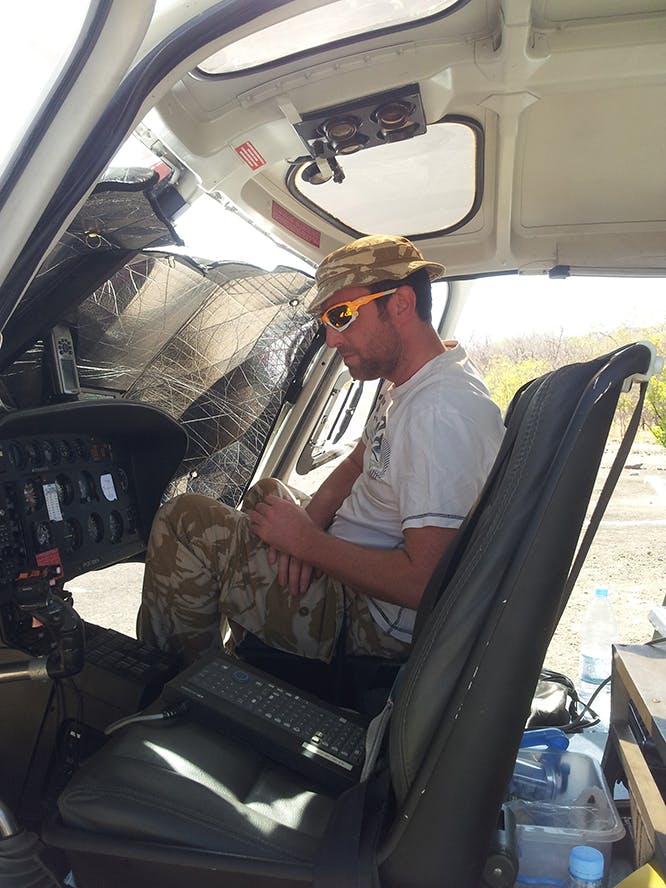
Air medical evacuation is an area of private aviation charter that is set apart from private business or leisure flights.
Otherwise known as medevac (or sometimes medivac) flights, this is the sector of our industry that provides private air transport for patients who are too ill to travel long distances by ground – and who are too ill or weak to undergo the experience of a commercial airline flight.
An air ambulance is the term given to a private aircraft that has been specifically equipped for a patient that requires extensive or urgent medical assistance during transportation. Some aircraft are most suitable for converting to an air ambulance. Find out more and see Top 5 most popular air ambulance aircraft.
Obviously the aircraft and its equipment are important components of the required medical care, but a medevac patient will also require expertise from trained medical professionals during the flight. Depending on the nature of the patient’s condition and the flight, the medical crew could include doctors, nurses, or paramedics.
Here we interview paramedic Matt Archard, to find out more about the role of a paramedic in aviation.
Q: Matt, can you summarise the role of a paramedic?
A: A paramedic is a medical professional who is trained to work in emergency medical situations. This means we provide care for a patient in a pre-hospital environment, at the point of illness or injury and in an emergency. Our role includes treatment and care of the patient during transportation to or from hospital or elsewhere, including in an aircraft. We sometimes work as part of a larger medical team, and sometimes alone.
Q: Did you always want to be a paramedic? What’s been your career path to your current role?
A: I didn’t initially have ambitions to work in the medical field. But during my 7 years in the British Army, from 1997 to 2004, I took a Team Medics course (after being involved in some serious incidents whilst serving operationally) and really enjoyed it. I went on to train as a Ambulance Technician on leaving the army and have continued to study since for a number of further medical qualifications.
After leaving the Army I worked voluntarily in Cape Town, on Emergency Response Vehicles and Ambulances. I was looking to combine medical and security care, so I studied for a Close Protection qualification in Cape Town and realised that my ideal role would be to work as a paramedic within a security team. I went on to work in the close protection industry for VIPs and royals in the Middle East, and then for high profile teams and individuals in Europe and the USA. Three of those years were based in Washington DC on a high profile diplomatic team. I also worked in front line Emergency Ambulance support in the UK, working privately for the NHS.
In 2010, I went back to full-time study to complete a degree in Health & Social Care, Paramedic Science. This enabled me to start work as a freelance paramedic and I have enjoyed varied roles since in the UK, across Europe and in more conflicted areas of the world such as Iraq and remote gold exploration sites in Senegal West Africa, where my security experience is a strong asset. Some of the work is ground-based but a significant proportion of my time is spent in aviation, assisting safe passage, transporting patients and repatriating them from overseas.
Currently I spend some of my time working out of Baghdad, as a freelance paramedic within a PSD (Private Security Detail) team for Shell. I am also about to start studying again – for a Masters degree in Critical/Intensive Care Management. I am committed to developing my professional development and intend to work hard to develop further knowledge within my profession. The way I see it, the more I learn, the more I can help!
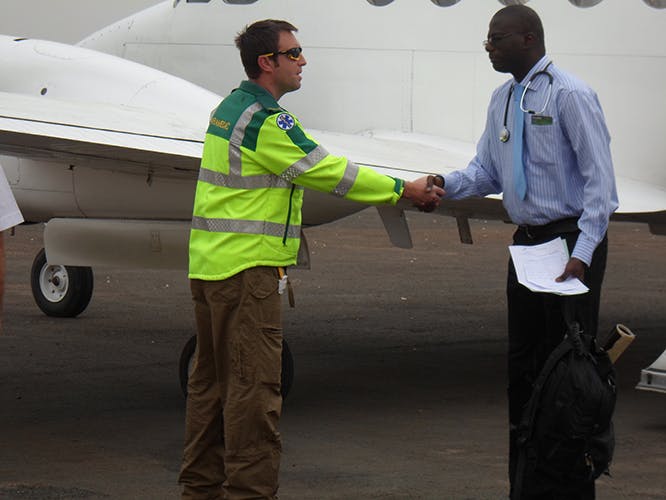
Q: Can you describe a typical scenario for a medevac flight?
A: There is no typical scenario for a flight really, it’s very varied – one of the things I enjoy so much about the role. It might be repatriating a patient who has experienced a stroke while on holiday, perhaps having had a heart attack or an accident or someone who just needs a hand mobilizing. But broadly I would separate the types of flights that I work on, into these four types:
1) Escorting a patient as part of a medical crew, with a doctor and nurse. This would be the most critical scenario, transporting a patient with a life-threatening condition, who requires intensive care treatment by a specialist crew.
2) Working with a nurse or another paramedic. This is when a doctor is not required, but the situation needs two pairs of hands or other possible eventualities are anticipated. It might also be when a patient has specifically requested female assistance.
3) Flying independently as a paramedic.
4) Flying independently as a medically-trained escort. This is when the patient may not require immediate medical treatment, but is someone who is vulnerable or susceptible to health problems and has requested to have medic onboard. This could be on a private flight or on a commercial airline flight.
Q: What are the key skills required to be a paramedic?
A: Obviously it’s essential to have the required medical training. But communication skills are also really important, to be able to keep both the patients and their families (who are often onboard) as calm and comfortable as possible during the flight, in what is often a frightening and stressful situation. And as I said before, it’s a varied role, so you have to be adaptable and able to cope with the unexpected.
Its equally and just as important to maintain a level of knowledge once taught – to continue and develop your skills in an ever changing developing profession where skill fade is a potential risk.
Q: How has your military background benefited your career since leaving the Army?
A: I think my experience in the Army has been a huge benefit. It helps me to stay calm under pressure and to adapt to challenging situations. It has taught me the importance of both independence and teamwork and, most of all, a great respect for those around me. I find myself drawing on my Army training to some extent every day.
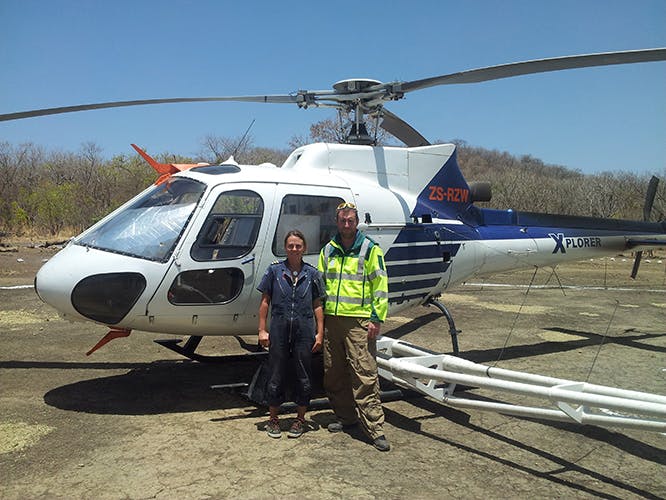
Q: What equipment do you carry onboard the aircraft?
A: The Air Ambulance aircraft we use for a full critical response carries extensive medical equipment including ventilators, heart monitoring equipment and other specialist items. Quite often we use a Lifepak 15 cardiac monitor – a defibrillator that has built in functions such as blood pressure, pulse and oxygen level capabilities.
We also carry drug supplies and ample oxygen – more than is usually carried on a passenger flight. Being so far away away and out of reach from hospital, its important to equip yourself accordingly, making every effort to bring the hospital to the patient.
Q: What makes air transportation different to working as a paramedic on the ground?
A: The environment and increased movement of an aircraft, especially on take-off and approaching to land – can make it more challenging to keep a patient comfortable. The cabin air pressure (altitude) also means the body can respond differently to certain conditions – and it can impact the choice of medication or treatment in some cases. The logistics can also be more complicated, when you are transporting patients between countries and over long distances. That’s why we receive specialised training for air transport and I would like to develop my skills further in my critical care studies.
Q: How does working overseas compare to working in the UK?
A: Working overseas as a paramedic is attractive for several reasons. Firstly and quite honestly the remuneration is better. Working in remote and hostile areas such as the jungle of West Africa or within operational Security teams in Iraq is challenging for all the obvious reasons, but financially it can be very rewarding – sometimes allowing you to earn 5 times the average paramedic’s wage in the UK. It can also be exciting to work under those conditions, knowing you have an opportunity to make a real difference to peoples lives whilst working under immense pressure.
Working in the UK is not without its dangers or excitement though, I might add! It also gives me the opportunity to fine tune my skills in a ‘best practice’ environment. I have learnt so much working alongside such committed and experienced medical professionals.
Q: What type of aircraft have you flown in with patients?
A: I have worked onboard a variety of fixed wing and rotary aircraft including:
- King Air
- Cessna 206 boat plane
- Gulfstream jets
- Learjets
- Hawker 800
- Eurocopter 135
- Eurocopter A350 Squirrel
- 315 Lama
- Many commercial airliners including the Boeing 747 and the Boeing A380 Airbus
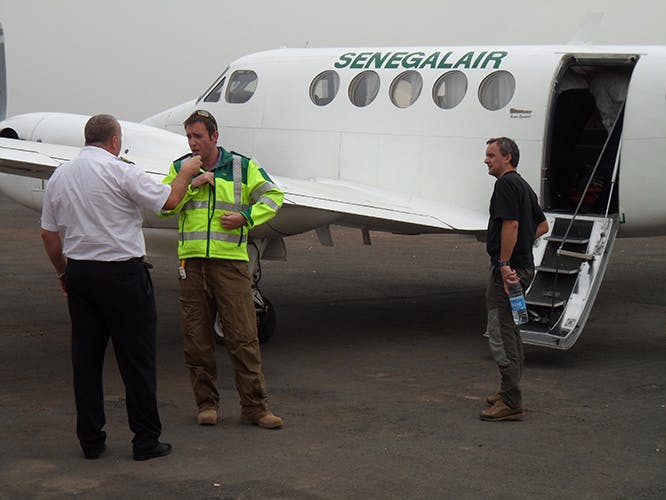
Q: What countries have you visited whilst working?
I have transported patients to and from England, Spain, France, Belgium, Switzerland, Austria, Iraq, Dubai, Korea, Fiji, USA, Canada, Senegal, Tanzania and South Africa.
And I am sure there are many more to come!
Q: What do you hope to do next in your career?
A: I would love to develop new skills within the aviation sector and that’s an area I am focussing on as a specialism in my Masters degree. In terms of location, I am based out of Middle East for a third of my time so, with a young daughter and another baby on the way, I am looking to spend more of my time in Europe, ideally Spain where they are based. I’ve missed them terribly.
For more information or rapid-response advice on medevac flights, you can contact PrivateFly’s 24-hour flight team on +44 1747 642 777.
Matt Archard is currently looking for a new role in Europe, while he studies for his Masters degree.
Email: matthewarchard@yahoo.com
Related content
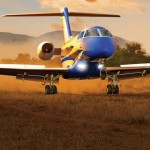
5 ‘off-road’ private aircraft for remote landings



